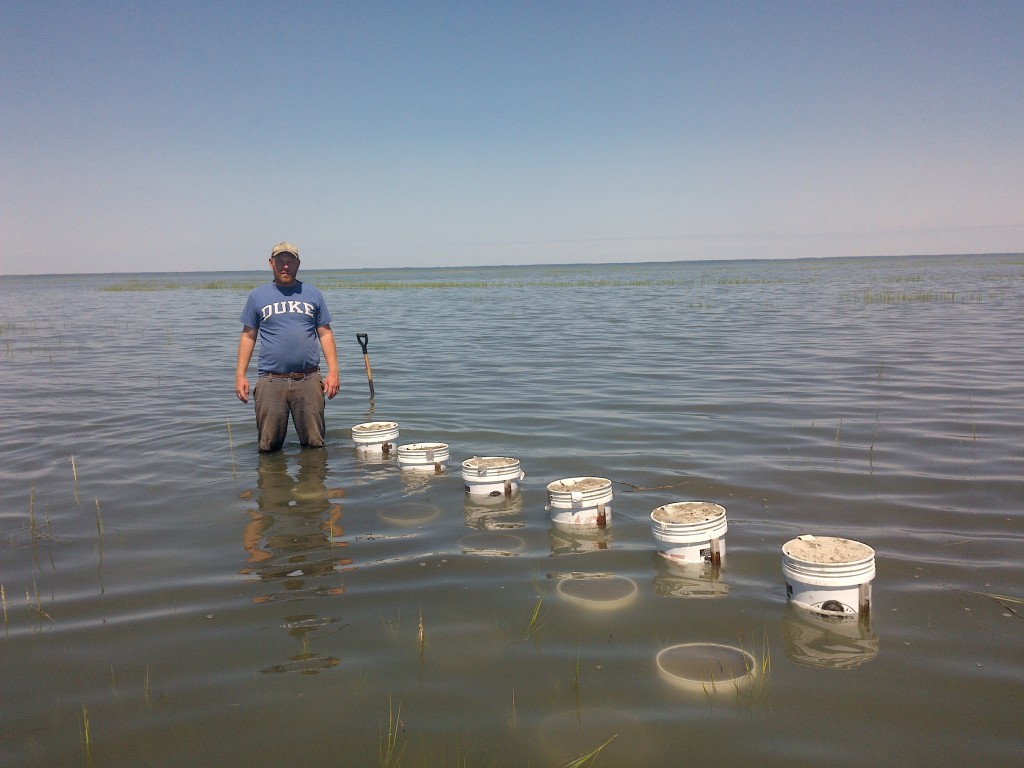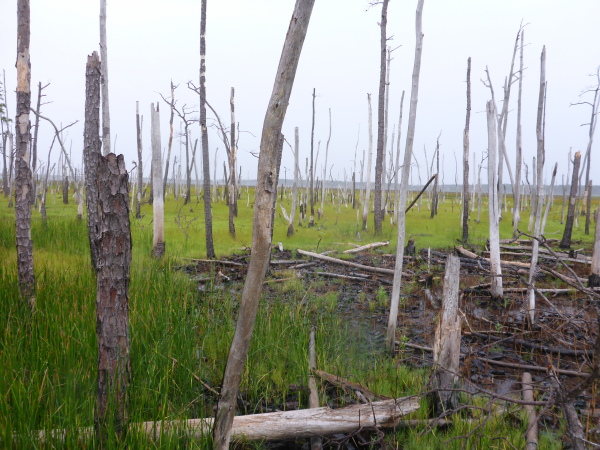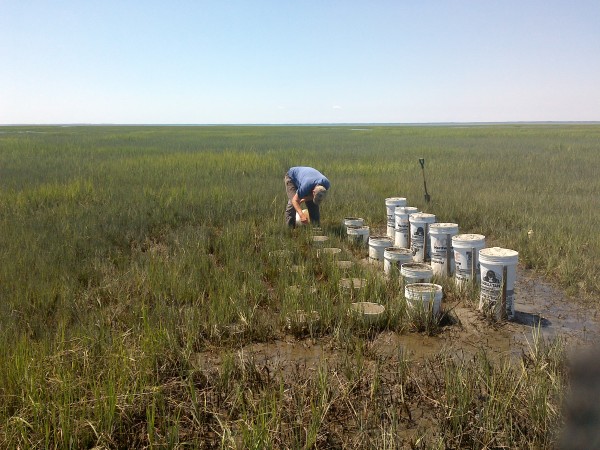Eco Spotlight: VIMS Assistant Professor Matt Kirwan

VIMS Assistant Professor Matt Kirwan on Hog Island, VA where he is simulating overwash fan deposition to measure the impacts of storms on marshes. Photo by David Walters.
Most William & Mary undergrads spend their time shut up in Swem library or lounging on the Sunken Garden. Matt Kirwan spent his time out on the marsh. In 2001, Kirwan’s father bought 200 acres of marshland on the Delmarva Peninsula near a place called “Kirwan’s Neck.” Kirwan and his cousins spent their time hunting deer and muskrat, learning the way of the land.
These pastimes led to a passion. Once graduating from W&M in 2002 with a geology major and a math minor, Kirwan went to Duke’s Nicholas School of the Environment to earn a PhD. No matter how much time he spent in the classroom, spending time on the marsh was far more educational. “I have some cousins who know more than I ever will, because they’ve lived on the marsh for more than 80 years in some cases. You need to live in the environment and depend on it to really understand it,” he stresses.
It’s no wonder why. Marshes are among the most productive ecosystems on earth, a fact you may have heard before. Less well known is why marshes are so productive, or what “productivity” itself means. Living on marshes, or any other natural environment, greatly enhances your understanding and appreciation for these dynamic ecosystems.
Kirwan defines productivity as the amount of biomass an ecosystem produces, i.e. how much carbon it takes out of the air and puts into biomass (leaves, roots, and stems). You might imagine a steamy rainforest, where explorers whack their way through dense leafy growth. Marshes are similarly productive, minus the machetes. While rainforests are notably diverse ecosystems, some marshes are close to monocultures. The most common salt marsh plant is the “miracle plant” Spartina alterniflora, a long, wavy grass. “It can handle being flooded twice a day, it can handle being in full-strength seawater some of the time and completely fresh water other periods of time – and not only can it handle that, but it’s insanely productive,” Kirwan explains. “Sometimes more diverse isn’t necessarily better… You’ve got one plant that’s adapted to handle those really stressful conditions and it does it really well.”
So not only are marshes productive, but they also provide a variety of ecosystem services for humans such as storm protection, fish and wildlife habitat, and carbon sequestration. Fantastic, right? Unfortunately, marshes aren’t being treated with such consideration. Nearly half of the entire world’s wetlands have been converted into seafood aquaculture, rice paddies, parking lots, buildings, and other alternative land uses. Kirwan is currently researching how marshes respond to these changes as well as sea level rise. Marshes erode on their seaward edge and migrate inward onto the land. Typically, if the sea level rises, the marsh can simply move inward accordingly. In the real world, marshes are limited by sea walls, berms, ditches, and even our own homes and backyards. These structures were all designed to combat sea level rise, but they also keep out the marsh and give it nowhere to move.
Some believe marshes could replace these structures altogether to combat sea level rise. Given a little bit of room to expand, marshes can actually raise their elevation along with the encroaching water, due to the sediment deposition along its edge. “When marshes are left to their own devices, they are fantastically sustainable ecosystems. Everything about them is built to persist,” Kirwan says.
In many instances, marshes can be relatively easy to restore – the right conditions combined with a little bit of sediment and vegetation and bam! Instant marsh. However, a constant source of sediment is needed to keep them growing. With many rivers dammed or diverted these days (for flood control, drinking water, or hydropower), sediment is trapped and held back before it can reach the marsh. The only other sedimentation strategy is to physically put sediment on top of the existing marsh. This, understandably, is not ideal. “Unless you restore the sediment source, it’s not going to be sustainable,” Kirwan says. “You’d have to do it again a decade later.” It’s the cruelest irony; the very structures we put in to keep back the seas are harming our most promising natural infrastructure that would do the same.
Carbon sequestration is another exciting future area of research, and another important ecosystem service marshes provide. As any plant lives and grows, it takes in gases (including carbon dioxide) into its tissue. However, marshes and plants like trees sequestering carbon have one striking difference. As a tree dies, it decomposes on the forest floor and releases most of the carbon it took in. As marsh plants die, they are buried under water or anoxic sediment. This prevents the plant from fully decomposing and releasing carbon back into the atmosphere, effectively trapping the carbon. While marshes are only 2% of the earth’s surface, they sequester carbon at a rate a full order of magnitude higher than any terrestrial ecosystem. “It’s basically a new science,” Kirwan says. “We have a decent handle on how much carbon they sequester, but no idea on the processes that control how fast it’s sequestered.” Scientists are only now beginning to explore this huge potential impact in carbon sequestration, a significant addition to marshes’s list of benefits. For Kirwan and others, much work remains to be done.
Want to get involved?
Matt Kirwan is currently looking for interested students to help with his ongoing and future research projects located in and around the Chesapeake region including:
- Carbon sequestration
- Marsh response to sea level rise and storms
- Paleoecology and geomorphology
- GIS and numerical modeling of marsh persistence
Want to know more?
- Read Matt Kirwan’s paper, “Tidal wetland stability in the face of human impacts and sea-level rise.”
- Visit his website or contact him at kirwan@vims.edu.
Want to visit a local marsh ecosystem?
- Kayak on Taskinas Creek at York River State Park
- Drive on the John Tyler Highway and the Colonial Parkway – You can visit freshwater marshes on James River at the Chickahominy Riverfront Park and then drive to Yorktown, checking out a number of salt marshes and creeks along the way.






No comments.
Comments are currently closed. Comments are closed on all posts older than one year, and for those in our archive.